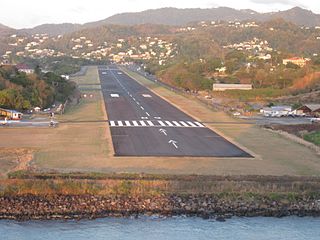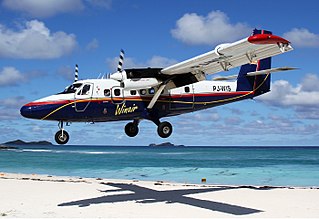Solomon Airlines is the flag carrier of Solomon Islands, based in Honiara.

Wardair Canada was a privately run Canadian airline, founded by Max Ward in 1952 under the name Wardair Ltd, before formally changing its name to "Wardair Canada" in 1976. The airline was acquired by and merged into Canadian Airlines in 1989.
Carnival Air Lines Incorporated was a charter and scheduled airline division of the Carnival Corporation & plc that started in 1988 after Carnival Cruise Lines purchased Pacific Interstate Airlines. It was headquartered in Dania Beach, Florida.

The De Havilland Canada DHC-8, commonly known as the Dash 8, is a series of turboprop-powered regional airliners, introduced by de Havilland Canada (DHC) in 1984. DHC was bought by Boeing in 1986, then by Bombardier in 1992, then by Longview Aviation Capital in 2019; Longview revived the De Havilland Canada brand. Powered by two Pratt & Whitney Canada PW150s, it was developed from the Dash 7 with improved cruise performance and lower operational costs, but without STOL performance. The Dash 8 was offered in four sizes: the initial Series 100 (1984–2005), the more powerful Series 200 (1995–2009) with 37–40 seats, the Series 300 (1989–2009) with 50–56 seats, and Series 400 (1999–2022) with 68–90 seats. The QSeries are post-1997 variants fitted with active noise control systems.

Las Américas International Airport is an international airport located in Punta Caucedo, near Santo Domingo and Boca Chica in the Dominican Republic. The airport is run by Aeropuertos Dominicanos Siglo XXI (AERODOM), a private corporation based in the Dominican Republic, under a 25-year concession to build, operate, and transfer (BOT) six of the country's airports. Las Américas usually receives a wide variety of long-, mid-, and short-haul aircraft. Santo Domingo's other airport, La Isabela, is much smaller and used by smaller aircraft only.

BWIA West Indies Airways Limited, known locally as "Bee-Wee" and formerly as British West Indian Airways and BWIA International Airways, was the flag carrier of Trinidad and Tobago. At the end of operations, BWIA was the largest airline operating out of the Caribbean, with direct service to the United States, Canada, and the United Kingdom. Its main hub was Piarco International Airport (POS), Piarco, with major hubs at Grantley Adams International Airport (BGI) in Barbados and Cheddi Jagan International Airport (GEO) in Guyana during 2006. It was headquartered in the BWIA Administration Building in Piarco, Tunapuna–Piarco on the island of Trinidad. The company slogan was Sharing our warmth with the world.

George F. L. Charles Airport is the smaller of the two airports in Saint Lucia, the other being Hewanorra International Airport. It is located 2 km (1.2 mi) north of Castries, the capital city. George F. L. Charles Airport is managed by the Saint Lucia Air and Seaports Authority (SLASPA). Its runway runs parallel to a pristine beach, Vigie Beach, which is a popular tourist attraction.

The de Havilland Canada DHC-6 Twin Otter is a Canadian STOL utility aircraft developed by de Havilland Canada in the mid-1960s and still in production today. Built by De Havilland Canada from 1965 to 1988, Viking Air purchased the type certificate and restarted production in 2008, before re-adopting the DHC name in 2022. In 2023 DHC restarted production of the 300 series, in addition to the Series 400 produced by Viking.

V. C. Bird International Airport is an international airport located on the island of Antigua, 8 km (5.0 mi) northeast of St. John's, the capital of Antigua and Barbuda.

LIAT (1974) Ltd, also known as Leeward Islands Air Transport Services and operating as LIAT, was a regional airline headquartered in Antigua and Barbuda that operated high-frequency inter-island scheduled services to 15 destinations in the Caribbean. The airline's main base was V.C. Bird International Airport, Antigua and Barbuda, with a secondary base at Grantley Adams International Airport, Barbados.
Tropical Airways was a small airline with scheduled and charter services based in Port-au-Prince, Haiti.

The de Havilland Canada DHC-7, popularly known as the Dash 7, is a turboprop-powered regional airliner with short take-off and landing (STOL) performance. Variants were built with 50–54 seats. It first flew in 1975 and remained in production until 1988 when the parent company, de Havilland Canada, was purchased by Boeing in 1986 and later sold to Bombardier. In 2006 Bombardier sold the type certificate for the aircraft design to Victoria-based manufacturer Viking Air.
Caribbean Star Airlines was an airline based in Antigua and Barbuda. It operated scheduled passenger services in conjunction with Leeward Islands Air Transport (LIAT) to destinations in the eastern Caribbean. Its main base was VC Bird International Airport, St John's. The company slogan was A Whole New Altitude.

Time Air was an airline in Canada founded in 1966 by businessman Walter “Stubb” Ross from Lethbridge in Alberta. It was called Lethbridge Air Service before becoming Time Airways Ltd. in 1969, which was later shortened to Time Air Ltd. In 1993 it was merged with Ontario Express to create Canadian Regional Airlines.
Trade Air d.o.o. is a Croatian passenger and cargo charter airline headquartered in Zagreb and based at Zagreb Airport. The company is registered as an airline whose main activities are passenger charter flights and cargo operations, organised either on charter chain flights or ad hoc flights. Trade Air also specialises in the transportation of dangerous goods.
Isleña de Inversiones S.A. de C.V. branded Avianca Honduras is a regional airline based in San Pedro Sula, Honduras. It offered mostly scheduled and chartered passenger flights out of its hub at Ramón Villeda Morales International Airport. It was formerly one of the airlines part of Grupo TACA. It is one of the seven nationally branded airlines in the Avianca Group of Latin American airlines.
Sunstate Airlines is a subsidiary of Qantas which operates regional flights under the QantasLink banner throughout New South Wales, Queensland, Victoria and to Canberra, Australian Capital Territory. Its head office is in Mascot, New South Wales, Australia.
Caribintair was an airline that flew domestic and international routes from Port-au-Prince, Haiti. It was established in 1989. Operations stopped in April 2009.
Aeronaves Dominicanas is an air charter airline established in 1980 with facilities in Samaná El Catey International Airport, and main offices in the La Isabela International Airport, Santo Domingo, Dominican Republic.
Santiago Municipal Airport was a both passenger and military airport located in the Center of Santiago de los Caballeros, Dominican Republic. This airport served this city with daily flights to San Juan in Puerto Rico, Port-au-Prince in Haiti, Santiago de Cuba, Miami and others. It was the major hub of Dominair, who had based two Dash 8 here. It was also used as a secondary hub by the FAD.









